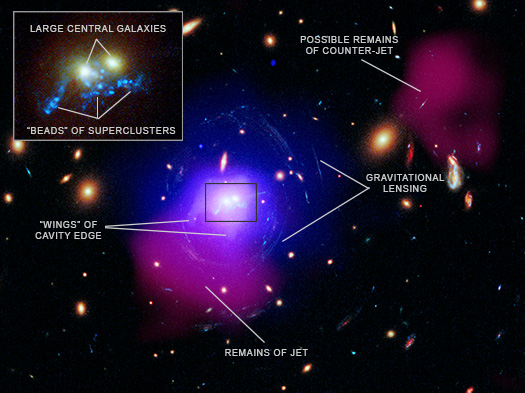Astronomers have discovered one of the most powerful eruptions from a black hole ever recorded in the system known as SDSS J1531+3414 (SDSS J1531 for short). As explained in our press release, this mega-explosion billions of years ago may help explain the formation of a striking pattern of star clusters around two massive galaxies, resembling “beads on a string.”
SDSS J1531 is a massive galaxy cluster containing hundreds of individual galaxies and huge reservoirs of hot gas and dark matter. At the center of SDSS J1531, which is located about 3.8 billion light-years away, two of the cluster’s largest galaxies are colliding with each other.
Astronomers used several telescopes to study SDSS J1531 including NASA’s Chandra X-ray Observatory, and the Low Frequency Array (LOFAR), a radio telescope. This composite image shows SDSS J1531 in X-rays from Chandra (blue and purple) that have been combined with radio data from LOFAR (dark pink) as well as an optical image from the Hubble Space Telescope (appearing as yellow and white). The inset gives a close-in view of the center of SDSS J1531 in optical light, showing the two large galaxies and a set of 19 large clusters of stars, called superclusters, stretching across the middle. The image shows these star clusters are arranged in an ‘S’ formation that resembles beads on a string.
The multiwavelength data provides signs of an ancient, titanic eruption in SDSS J1531, which a team of researchers think was responsible for creation of the 19 star clusters. Their argument is that an extremely powerful jet from the supermassive black holes in the center of one of the large galaxies pushed the surrounding hot gas away from the black hole, creating a gigantic cavity. The evidence for a cavity comes from “wings” of bright X-ray emission, seen with Chandra, tracing dense gas near the center of SDSS J1531. These wings are the edge of the cavity and the less dense gas in between is part of the cavity. LOFAR shows radio waves from the remains of the jet’s energetic particles filling in the giant cavity. These features are highlighted in a labeled version of the image.

The astronomers also discovered cold and warm gas located near the opening of the cavity, detected with the Atacama Large Millimeter and submillimeter Array (ALMA) and the Gemini North Telescope, respectively. A separate graphic shows the optical image with the cold gas added in green (left), and the warm gas added in red (right). The team argues that some of the hot gas pushed away from the black hole eventually cooled to form the cold and warm gas shown. The team thinks tidal effects from the two merging galaxies compressed the gas along curved paths, leading to the star clusters forming in the “beads on a string” pattern.

A paper led by Osase Omoruyi of the Center for Astrophysics | Harvard & Smithsonian (CfA) describing these results has recently been published in The Astrophysical Journal and is available online here. The authors of the paper are Grant Tremblay (CfA), Francoise Combes (Paris Observatory, France), Timothy Davis (Cardiff University, UK), Michael Gladders (University of Chicago), Alexey Vikhlinin (CfA), Paul Nulsen (CfA), Preeti Kharb (National Centre for Radio Astrophysics — Tata Institute of Fundamental Research, India ), Stefi Baum (University of Manitoba, Canada), Christopher O’Dea (University of Manitoba, Canada), Keren Sharon (University of Michigan), Bryan Terrazas (Columbia University), Rebecca Nevin (Fermi National Accelerator Laboratory), Aimee Schechter (University of Colorado Boulder), John ZuHone (CfA), Michael McDonald (Massachusetts Institute of Technology), Hakon Dahle (University of Oslo, Norway), Matthew B. Bayliss (University of Cincinnati), Thomas Connor (CfA), Michael Florian (University of Arizona), Jane Rigby (NASA Goddard Space Flight Center), and Sravani Vaddi (Arecibo Observatory)
NASA's Marshall Space Flight Center manages the Chandra program. The Smithsonian Astrophysical Observatory's Chandra X-ray Center controls science operations from Cambridge, Massachusetts, and flight operations from Burlington, Massachusetts.
This is an image of a cluster of galaxies called SDSS J1531+3414 in X-ray, optical, and radio light. The overall scene resembles a colorful display of lights as if viewed through a wet, glass window.
Blurry orange dots of different sizes are scattered across a black background. These orange dots are entire galaxies. Near the center of the image, two central galaxies appear as bright, white dots. Star clusters, resembling beads on a string in shades of electric blue, sweep over the galaxy on the left, through the space in between the galaxy pair, and then lightly coil beneath both galaxies. Clouds of blue, X-ray light, and dark pink, radio light, surround the two galaxies.
The blue cloud spreads out for thousands of light-years toward the region above the central galaxies. The dark pink cloud, somewhat resembling the shape of an upside down spinning top toy, stretches far below the two galaxies and slightly toward our left. This dark pink cloud represents the remains of a powerful jet, produced by a supermassive black hole within one of the two central galaxies. In the upper right corner of the image, another dark pink cloud is present. This cloud may be the relic of a counter-jet from the same black hole outburst.
|
||||||||||||||||||||||||||||||


